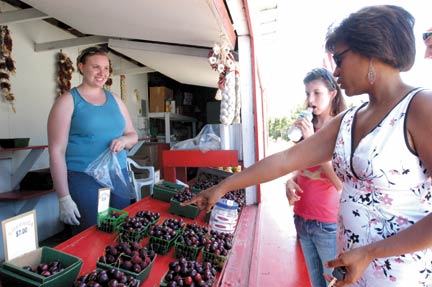Despite price decrease, nursery crops top the list; mushrooms
continue to grow in value
Morgan Hill – Nursery crops continue to top Santa Clara County’s 2005 agricultural report, despite competition from foreign nursery growers and rising gas prices that led to a $8.4 million price decline from last year, agricultural experts said.
Mushrooms on the other hand, increased in value and maintained the second position, up about $4.1 million from $53.9 million in 2004 to $58 million in 2005.
Nursery crops decreased about $8.3 million from $94.6 million in 2004 to $86.3 in 2005.
Jenny Derry, executive director of the Santa Clara County Farm Bureau, said the decline was not linked to local nursery operations.
“We have great growers here in Santa Clara County,” Derry said.
Derry explained that the high cost of gas and electricity that run greenhouses, drives costs up, and that cheaper labor in countries such as Colombia and Mexico make for less profit for local farmers.
Deputy Agriculture Commissioner Kevin O’ Day said that Sudden Oak Death, a fungus disease, added to the decline in nursery crop stocks. A quarantine meant to prevent the spread of the disease places further restriction on shipping of the crop, making it less desirable to buyers.
However, for the report’s number-two crop, mushrooms have continued to grow in value.
“The stars are mushrooms. They’ve been steadily increasing over the past years. Santa Clara Valley is one of the premier mushroom growing regions,” Derry said.
Agricultural biologist Lori Oleson said mushrooms had a good year for a number of reasons.
“Mushroom growers reported an increase in acreage, yield and prices,” Oleson said.
Greg Van Wassenhove, agriculture commissioner, said Santa Clara County’s high land prices, limited number of farmable acres of land, and the fact that multiple crops are harvested in a season make mushrooms an attractive crop to grow.
“Mushrooms are a high value crop, because a large amount of value can grow on small amount of acreage,” Van Wassenhove said. “Think of mushrooms like kids bunk beds all stacked on one another.”
Although total agriculture revenue fell by 2 percent this year, Derry said the decrease is not unusual.
“The 2 percent difference is normal fluctuation. In the last eight years, it has gone up and down a few million dollars every year,” Derry said.
Bell peppers, steer and heifers, cut flowers and grapes for wine rounded out the top five crops. Leaf lettuce, dry onions, fresh tomatoes and cherries finished in the top 10 crops, with fresh tomatoes being a newcomer to the top 10.
The report also documents an increase in steer and heifer value, up $1.1 million from $7.2 million in 2004 to $8.3 million in 2005. Prolonged rainfall this spring led to an extended grazing season, which resulted in calf weight gain, helping to boost the value of the stock.
Rachelle Gines is an intern attending San Francisco State University. Reach her at 847-7158 or rg****@************ch.com.








